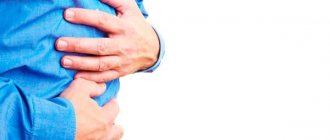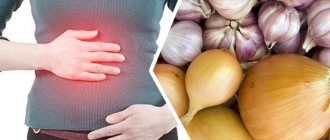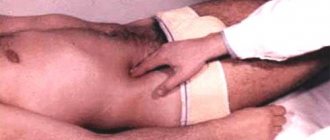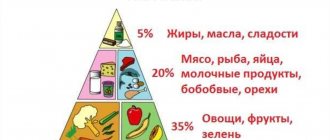Every person knows what abdominal pain is. It can be caused by physiological reasons, external unfavorable factors or various diseases. Many patients try to cope with this problem on their own. Sometimes it works. But there are conditions in which medical attention is absolutely necessary. Such conditions include girdle pain in the abdominal area. It can be acute or chronic, severe or aching. In addition to pain, other symptoms may occur. It is very important to consult a doctor in such a condition, and not try to alleviate your condition on your own. After all, such pain is most often a sign of serious pathologies that require special treatment.
Why might there be girdling pain in the abdomen?
There are not so many reasons for this phenomenon, and they all “speak” of the presence of disturbances in the functioning of the organs of the digestive system and not only.
Possible causes:
- Pain of this nature may be a sign of spasm; this phenomenon is rare, provided that it is acute but not prolonged.
- If they are localized predominantly on one side, they indicate the presence of problems with the kidneys and genitourinary system.
- If a chill appears in the stomach and similar, unpleasant sensations, one should suspect the presence of disorders in the functioning of the digestive system.
- Pain in the lower abdomen, with characteristic symptoms, “speaks” of the presence of problems with the pancreas.
- If such a phenomenon is accompanied by the appearance of vomiting and bitterness in the mouth, then it is worth thinking about the health of the liver and gall bladder.
It is extremely difficult to determine on your own the reasons for the pain and what they are associated with. The culprit may not only be diseases of the internal organs, but also more commonplace cramps that occur when overeating or eating low-quality food.
What is the reason
If the liver is damaged, you may experience pain in the right hypochondrium.
In the area of the right hypochondrium are located:
- Pancreas
- Gallbladder
- Liver
- Right kidney
Dysfunction of these organs due to the occurrence of inflammatory processes in them can provoke pain. In addition to lesions located near organs, other diseases can cause pain in the right hypochondrium.
Why are girdling pains dangerous?
The danger of such sensations is due to the fact that they can be a sign of a serious illness and for this reason they should not be ignored.
In what cases may sensations indicate the development of pathological processes in the human body:
- if accompanied by an increase in body temperature;
- provided that the sensations are acute and there is no way to eliminate them on your own;
- in the presence of pathologies in the functioning of the organs of the digestive system;
- if, in addition to unpleasant sensations, a person has other symptoms: vomiting, belching, heartburn.
Pain is dangerous because it can disrupt the usual rhythm of life, introducing its own adjustments, which is not always convenient for a person.
If unpleasant sensations appear with frightening frequency, occurring more often than 2-3 times a day, then you should consult a doctor for help.
Types of shingles pain
Each person has back pain in their own way - everything will depend on the reasons that provoked the pain syndrome. There are three types of shingles pain:
- aching;
- chronic;
- spicy.
If you experience girdling pain in your back above the lower back, determine the nature of the pain syndrome before contacting a neurologist
in order to describe your condition to the specialist in as much detail as possible.
Aching pain
Such pain has no clear localization, it hurts as if everywhere and constantly. The aching pain does not go away for a very long time; sometimes, for it to go away, a person needs to take a lying position, and only after a while the condition improves.
Chronic pain
This type of pain syndrome has quite a lot in common with aching pain. Their main difference is that they are permanent. Chronic pain can occur after you have suffered from a lung disease, such as inflammation or pleurisy, or as a result of heart problems.
Acute pain
Such pain is quite rare, and it is not difficult for the patient to clearly determine exactly where it hurts. The attack may be so severe that an ambulance will be required and immediate hospitalization will be required. As a rule, the location of the pathology coincides with the location of the pain. If you experience girdling pain in your lower back, do not hesitate to visit a doctor, as worsening the condition can cause the aching pain to become acute.
Shingling pain in the lower back and back
Table 2. More often they indicate the presence of the following disorders in the functioning of the human body:
| Problems with the kidneys and urinary system. | We can talk about stones that disrupt the functioning of organs. If the stone is “moved”, then pain appears, which causes a lot of anxiety and radiates to the lower abdomen. When urinating, the discomfort intensifies. |
| Kidney inflammation or pyelonephritis. | A dangerous disease that can change the structure of organs. Accompanied by a sharp increase in body temperature and intoxication of the body. Disturbance of urine outflow. |
| Lumbar, girdle pain can be a symptom of spinal injury. | In this case, a person feels stiffness when making certain movements. When you take a comfortable position, the intensity of the sensations decreases. |
In women, such pain signals pathologies of the internal organs of the reproductive system. May be accompanied by acyclic discharge, bleeding, weight loss or gain.
It is difficult to determine the reasons for which such problems arose, so as not to encounter complications of the disease, you should take timely measures and contact a medical institution.
Acute appendicitis
When the appendix is inflamed, the patient feels pain in the right side.
With inflammation of the appendix, the patient may also feel pain in the right hypochondrium. Despite the location of this organ in the area of the right ilium, pain can occur anywhere in the abdominal cavity. During an attack of appendicitis, a patient may feel:
- Pain in the navel or stomach area
- Prolonged pain in the right side of the abdomen
- Reduced pain when turning the patient on the right side
- When turning on your left side or walking, the pain intensifies
In addition, you may experience:
- Vomit
- Diarrhea
- Temperature increase
- Thoracic osteochondrosis
Thoracic osteochondrosis is often accompanied by aching pain, radiating to both the right and left hypochondrium. Degenerative changes occurring in the spine affect neighboring organs. The pain may worsen when you inhale or when you exhale.
Girdle pain in the abdomen and stomach
When identifying a symptom, much depends on the accompanying signs and complaints that the patient makes.
Table 3. In what cases such problems may cause concern:
| Severe poisoning. | In this case, there is a feeling of coldness and numbness in the limbs. A person refuses food, drinks a lot, and suffers from dry mouth. The liver may be enlarged and a clinical picture of an “acute abdomen” may be observed. |
| Pathologies in the liver. | If there is pain, with a characteristic bitter taste in the mouth. The patient is worried about vomiting, unpleasant belching after eating, and the body temperature may increase significantly, even to the development of fever. |
| Heart attack. | Surprisingly, abdominal pain, pressure in the chest, vomiting and a feeling of lack of air are symptoms of a heart attack. The disease progresses quickly; shortness of breath appears; the person speaks, breathes and moves with difficulty. |
| Diseases of the stomach and intestines. | Even gastritis can have similar symptoms, accompanied by the appearance of girdle pain in the abdomen, not to mention other diseases of the digestive system, with a more complex clinical picture. |
There are a number of factors worth paying attention to. After all, unpleasant sensations directly indicate that pathological processes are occurring in the body. What you should be wary of:
Spinal diseases
One of the common reasons why back pain in the lumbar region after sleep is various pathologies of the spine. Localization of pain in the lumbar region indicates that the source is located in the lumbar spine. There are the following pathological conditions that provoke this unpleasant symptom:
Osteochondrosis
We are talking about lumbar osteochondrosis, when various tissues of the lumbar region are damaged. The pain is caused by the fact that the disease affects the nerve endings, which is why the lower back hurts during sleep, even on the back and after it. The only way to stop the pain is to actively treat the disease, since advanced osteochondrosis results in even more serious complications and painful manifestations.
Spondylolisthesis
This is a spinal pathology in which one of the vertebrae is displaced forward and backward. If the lumbar region hurts after sleep, it is in this part of the back that a change in the structure of the spine has occurred. Most rarely, spondylolisthesis is caused by traumatic lesions of the spine; more often it is a congenital anomaly or the result of neoplasms affecting the vertebra.
Spondylosis
Consequence of untreated lumbar osteochondrosis. Hard bone tissue grows around the spine, forming spines that periodically touch soft tissue. This causes back pain in the lumbar region after sleep. Spondylosis often accompanies other chronic diseases of the spine. This condition is typical for older people.
Intervertebral hernia
It is characterized by rupture of the fibrous ring of the intervertebral disc and compression of the nerves. This causes back pain in the lumbar region after sleep, lasting all day. The spine in the lumbar region is most vulnerable to the pathological condition, since it bears the highest load.
Spondyloarthrosis
This is a lesion of the intervertebral joints, which is often combined with osteochondrosis and spondylosis. The connections between the vertebrae are disrupted, resulting in pinched nerves and discs. Therefore, after sleep, back pain occurs in the lumbar region. Spondyloarthrosis is often provoked by developing vertebral diseases; it occurs with vitamin deficiencies.
Pain as a consequence of an untreated illness
In the acute stage, with an acute course, many diseases are accompanied by pronounced pain. But with adequate and timely therapy, the sensations lose their intensity.
If the pain returns again, then the reason for this is a disease that has not been completely cured. In what cases does this happen:
- in case of insufficient correction of the condition, when the patient independently stops taking medications without consulting the doctor;
- when the drugs were selected incorrectly, only symptomatic therapy was carried out, which could not rid the person of the cause of the development of unpleasant sensations;
- if the patient repeatedly neglected the doctor’s recommendations, violated the prescribed regimen, did not follow the diet and rest.
The appearance of pain indicates that the pathological process has entered a chronic stage of development and now it will be much more difficult to get rid of it than before. It is necessary to stop the symptoms, and then begin treatment of the underlying disease again.
How to give yourself first aid for severe girdling pain
Self-treatment of diseases of various origins is unacceptable, but it is still possible to provide first aid to yourself if symptoms increase.
Table 4. What to do and what not to do:
| Allowed: | Prohibited: |
| Take an antispasmodic. | Drink alcohol. |
| Remain calm and do not make sudden movements. | Eating fried, fatty foods, carbonated drinks can worsen the symptoms. |
| Drink warm water to relieve the condition. | Take antibacterial or other drugs that are highly toxic. |
| Take sorbents if signs of intoxication appear. | Engage in heavy physical labor. |
| If there is no high body temperature and no signs of bleeding, then place a heating pad on the abdomen or lower back (depending on the location of the pain). | Lie in a hot bath and perform contrast procedures. |
| Call an ambulance if the intensity of the sensations does not decrease. |
ethnoscience
Acts as an adjunct to the main treatment and is not very effective. When using traditional medicine, it is worth considering that they often lead to the development of an allergic reaction and can aggravate the patient’s condition.
Table 6. What will help in the fight against pain:
| Decoctions of medicinal herbs and plants. | More often we are talking about oak bark, an infusion of walnut partitions; they have a pronounced astringent effect and help in the treatment of poisoning. |
| Saline solutions. | They do not relieve pain, but are indispensable if you need to flush the stomach or reduce the severity of intoxication in the body. |
| Rosehip syrup and green tea. | They have a choleretic effect, promote its outflow, and are used in the treatment of liver diseases. |
| Lingonberry leaf decoction, cranberry juice. | They will help with diseases of the kidneys and urinary system, stimulate the outflow of urine, and reduce the intensity of unpleasant sensations. |
You can place a heating pad or dry heat on the abdominal area to alleviate the severity of unpleasant symptoms. Sit on your haunches for a while, placing your knees parallel, and lie in the fetal position.
Diagnosis and treatment
It all depends on the accompanying signs that worry the patient. You can contact several specialists, but since we are talking about abdominal pain, you will first need to consult with the following doctors.
Table 7. Specialists who can help
| Gastroenterologist. | Treats diseases of the digestive system. |
| Hepatologist. | Specializes in the diagnosis and treatment of pathologies of the liver and gallbladder, its ducts. |
| Nephrologist. | Specializes in the treatment of diseases associated with dysfunction of the kidneys and bladder. |
| Endocrinologist. | It will help to identify and correct diseases associated with disruption of the thyroid, pancreas and other endocrine glands. |
As part of diagnostic procedures, the doctor can prescribe various tests to the patient, ranging from general to highly targeted. This will help make the correct diagnosis and select therapy.
Among the examinations, an ultrasound of internal organs is required. Ultrasound helps to identify abnormalities in the structure and dysfunction of organs.
It is also common practice to prescribe other diagnostic tests, but here everything depends on the presumptive diagnosis that the doctor makes to the patient.
Acute pancreatitis has been dealt with. What about chronic?
If the toxic effect on the pancreas does not stop (for example, a person continues to drink excessively) or the organ was very damaged during the first (acute) episode of pancreatitis, the pain returns again and again.
During exacerbations of chronic pancreatitis, blood tests may remain normal. But over time, external signs may appear, which doctors detect by examining the pancreas using ultrasound (ultrasound), X-rays (CT or computed tomography) or magnetic resonance imaging (MRI). These are narrowing of the pancreatic ducts, the appearance of compactions in it - calcifications, as well as the appearance of cysts - bubbles with liquid in place of dead tissue. An examination for suspected chronic pancreatitis is carried out with another important goal - not to miss pancreatic cancer, which may initially be accompanied by the same symptoms.
With constantly renewed inflammation of the pancreas, its function—the secretion of enzymes that digest food—is disrupted over time. As a result, a person is bothered by constant bloating, diarrhea, and the stool becomes greasy (for example, it is difficult to flush from the toilet). This condition - exocrine insufficiency - is most conveniently identified by determining the content of pancreatic elastase (a pancreatic enzyme) in the stool.
Do you need to go to the doctor?
A visit to a doctor is considered a necessity, since the lack of medical assistance in such a situation can lead to serious, undesirable consequences.
Conscious refusal of medical correction of a condition is fraught with the development of pathologies; this should not be forgotten. In addition, only a qualified specialist can accurately determine the cause of pain.
Girdles, sharp or other pain in the abdomen may indicate various problems. They are not considered a key symptom when prescribing and conducting diagnostic procedures, but they complement the clinical picture well. If such unpleasant sensations appear, you should consult a doctor and go through a series of diagnostic procedures. This will help maintain health and avoid serious complications.
Cirrhosis
Similar symptoms are observed in liver cirrhosis. Pain begins in the last stages of the disease. First, an inflammatory process occurs in the liver cells, which subsequently leads to their death. In place of dead cells, connective tissue is formed, and the liver cannot cope with its work, reminding itself of aching pain in the right forearm.









